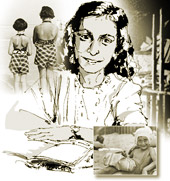 |
“You’ve known for a long time that my greatest wish is to be a journalist and later on, a famous writer. In any case, after the war I’d like to publish a book called The Secret Annex.” — Anne Frank, May 11, 1944
Standing in the darkened rooms of the secret annex, 60 years after the diary was written, it’s hard to fight the lump in one’s throat. Through the chink in the curtain one can see the street below and the canal with its boats going by, just as Anne and her sister Margot would have done for the 25 months that they lived there. They would have watched helplessly as Jewish families wearing the yellow star were rounded up and marched down the street below.
“Countless friends and acquaintances have been taken off to a dreadful fate. Night after night, green and grey military vehicles cruise the streets. It’s impossible to escape the clutches unless you go into hiding,” wrote Anne in 1942.
Anne thought she was lucky to have escaped their fate. Soon they were joined by another family, the van Pels, and their son Peter, and later by Fritz Pfeffer, bringing the number of residents in the tiny Annex to eight. Anne’s father, Otto Frank, tried to save as many people as he possibly could. Helped by his staff, the residents survived for two years, till they were betrayed and captured.
Anne began her famous diary on her 13th birthday on June 12, 1942, a few days before her family was forced to go into hiding in the annex of her father’s office in Amsterdam. The red- and-cream checked diary was a present from her father, and she immediately wrote in it: “I hope I will be able to confide everything to you, as I have never been able to confide in anyone and I hope you will be a great source of comfort and support.” She called her diary ‘Kitty’ and wrote to her as if to her closest friend.
Throughout the two years in hiding, the diaries became her place of solace where she expressed her innermost thoughts, anxieties, fear, anger and her first stirrings of love and attraction.
Today the house, which has become a museum, is celebrating Anne Frank’s 75th anniversary with a series of events and a special photo exhibition. The diary and the rooms are already part of the museum display. Visitors can enter the secret annex through the sliding bookcase which used to hide it and go up the steep stairs to the three rooms and the attic that the eight residents shared.
‘Anne Frank and Family’, an exhibition of photographs taken by Otto Frank of his two girls forms the focus of the new exhibition which is being simultaneously held in Amsterdam, Berlin and New York. Many of the 66 photographs on display have never been seen before. Otto Frank photographed his daughters with a Leica camera — rare in those days — when most people got family photographs taken in a studio.
His photographs were carefully composed using light and shade and often allowing his own shadow to appear in them. It is the work of a clearly adoring father, lovingly recording his daughters as they grow up and also experimenting with his new medium. Images of Anne and Margot on the beach, on their sun-beds, at school and in parties are faithfully captured.
The album begins in Frankfurt where Anne and Margot were born and then moves to Amsterdam where the family was forced to move to avoid persecution in Germany. Once they went into hiding, Otto Frank did not use his camera, possibly because the light was not enough.
The family had to use black-out curtains so no one would know the house was occupied. During the day they could not go near the windows or look out. From 8. 30 in the morning till the last worker left the office below in the evening, they were not allowed to move around, flush the toilet or make any noise that might alert the people below. Yet throughout their period in hiding the girls continued their lessons. Supplied with books by the helpers, Anne read copiously, satisfying her natural curiosity.
The four albums of photographs were taken into hiding by Otto Frank. After the war, Otto Frank never used his Leica again. “We started looking through the four albums when we were planning the 75th anniversary celebrations and I was struck by some of the photos,” said Jan van Kooten, director of education at the Anne Frank House. “Soon we found that they told a story without words.”
Anne wrote her last lines to “Dearest Kitty” on August 1, 1944. On August 4, the family was betrayed and all the eight residents of the annex and their helpers were arrested. Anne and Margot were sent to Bergen-Belsen concentration camp where both died of typhus and deprivation within days of each other. Their mother, Edith, died in Auschwitz. All the other residents of the annex died in various concentration camps.
Only Otto Frank survived, to learn that his whole family had been wiped out. The diaries and albums which had been found in the attic and preserved by the helpers, Miep Gies and Bep Voskuij, were handed over to Otto Frank when he returned from Auschwitz. He could not read the diary for a long time. Finally, knowing that Anne would have wanted him to, he decided to publish it in 1947.
Since then 30 million copies of the diary have sold. It has been translated into more than 60 languages including four Indian ones — Assamese, Bengali, Hindi and Malayalam. Every year about 9,00,000 people visit the museum. Stepping out into the June sunshine watching the queues of people lining the entrance to the museum, one can see why.
The story of a young voice silenced by history continues to inspire. “The war is going to go on despite our quarrels and our longing for freedom and fresh air, so we should try to make the best of our stay here... A person who’s happy will make others happy, a person who has courage and faith will never die in misery,” wrote Anne in March 1944.
A year later, eight months after her capture, Anne Frank died in Bergen-Belsen. A month later, the camp was liberated.











